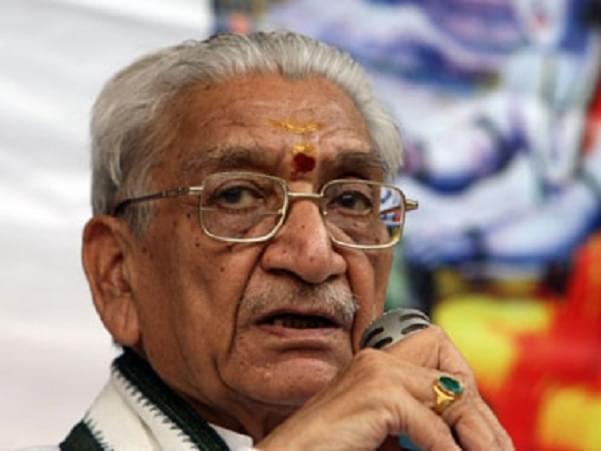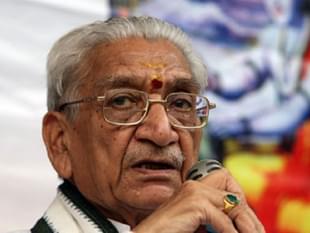Politics
How Ashok Singhal Fought The Caste Orthodoxy
Aravindan Neelakandan
Nov 19, 2015, 11:35 PM | Updated Feb 10, 2016, 05:57 PM IST
Save & read from anywhere!
Bookmark stories for easy access on any device or the Swarajya app.


Not many know that Ashok Singhal had a reformist side and often went against orthodoxy in his own camp.
In 2005 Suraj Bhan was the chairperson of the SC Commission. He had asked the religious authorities to remove all derogatory remarks perceived as demeaning to the scheduled caste communities in so-called scriptures such as Manu Smrithi. He conveyed his wishes to the Shankaracharya of Sringeri himself urging that this detoxification of Hindu scriptures must be done. But the orthodoxy claimed that there was not a single word of objection in the Hindu scriptures and that they need not be changed.
But a prominent non-ignorable personality, sided with Suraj Bhan and stated that Manu Smrithi did contain objectionable derogatory references and that they should be removed. He was the then VHP President Ashok Singhal. Perhaps this is not the defining memory of Mr.Singhal which is being projected to the collective psyche of educated Indians. He was generally projected as the quintessential rabble rouser, the man who launched the vicious Ayodhya movement and got the disputed structure razed to the ground.

But to those who had memories of being at Ayodhya, Ashok Singhal would always be remembered as the man who led from the front when Mulayam Singh had ordered police action against Karsevaks. Singhal was there in the front covering his bleeding head and still giving orders.
The Ayodhya movement and the massacre of the Karsevaks by the Mulayam Singh administration made him angry and the delay in the construction of the Ram temple at Ayodhya made him bitter. He did not understand the nuances of political compulsion and the pressures of coalition politics. So naturally he was upset with the Atal – Advani team.
While one cannot accept his Ayodhya centered worldview, one can see why he felt a sense of being betrayed by politicians. After all he had seen the bodies of Karsevaks being dumped by UP police into the Sarayu river hooked to sand bags in order to avoid easy recovery and identification.
Meanwhile, the VHP itself had stagnated because of its symbolic obsession with Ayodhya. Singhal himself was shown as the man who held the dictates of Hindu saints as superior to the constitution. But there was more to the man.
The way the law was ignored in Shah Bano case and the way Ayodhya settlement was dragged and delayed by the courts, made him utter some intemperate statements. But he did have a reformist side. He was for a rational approach to ‘scriptures’ like Manu Smrithi. In an important article titled ‘VHP’s view of ‘Manu Smriti’ and other Smritis’ Singhal wrote:
The VHP totally rejects the Manu Smriti as it has no place in a civilized & cultured society. The Srimadbhagavad Gita is, in fact, the Adi Manu Smriti (Original Code/Law of Manu) as revealed and related by Bhagwan Sri Krishna in Chapter IV of the Gita. The Dharma Sansad and the Maargadarshak Mandal of Vishva Hindu Parishad constituted of Dharmacharyas, Sants, Mahamandaleshwars and Mahants have totally rejected caste untouchability as prevalent in the Hindu society today. They have decided to give Mantra Deekshaa (initiation) without any discrimination.
True to his words, the VHP did train people from all communities including the scheduled castes, to become temple priests. On February 14, 2008, the famous Jagannath temple in Bihar got its chief priest from the Scheduled Caste community. Ashok Singhal should be seen as the force behind this drive who studied the caste problem historically and was forthright in providing a progressive solution.
The book authored by Ashok Singhal in Hindi ‘Srimadbhagavatagita hi aadi Manusmriti’ (‘Bhagvad Gita is the original Manu Smrithi’) provides a historically valid support to the reformist movement within the Hindutva organizations. When S.N.Goenka, the founder of Vipassana read this book by Singhal he was overjoyed and wrote a letter to Singhal in 2006. He wrote:
After reading Shri Singhalji’s book, I was delighted that a prominent leader has taken the initiative to reject these false beliefs. I am fully aware that some fanatics will oppose him. Only a strong leader like Shri Singhal ji can withstand such opposition. It is essential to take many more such beneficial measures to strengthen the unity and integrity of society and the nation. This first important step that has been taken in this direction is truly praiseworthy.
This aspect of Ashok Singhal is almost never discussed or projected. There was a reformist side to him. He frequently went against the orthodoxy in his own camp, especially when it came to justice for all.
Ashok Singhal was one of the architects of the Ayodhya movement that provided impetus to Hindutva. But more important is the task of uniting the Hindus who are separated by the notion of castes. The era of rabble rousing is over. In the modern era we need to democratize Hindu cultural spaces and Ashok Singhal was a net positive force in helping with that.
Aravindan is a contributing editor at Swarajya.





